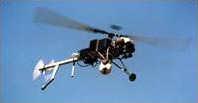

Like surveillance cameras, high-powered binoculars and armoured personnel carriers, helicopters are devices that were originally invented, manufactured and used during wars on foreign soil by the military, and that are now sold on the cheap to civilian law enforcement authorities (in the United States: the FBI, the BATF and the DEA), which use them for "operations other than war." Such "technology transfers" are in violation of the Posse Comitatus Act of 1878 (and all of the rulings that have been based upon it), because these transfers increasingly involve the US military in domestic law enforcement and thus create a military police state.
Technology transfers began in the late 1960s, when local police forces were nearly overwhelmed by huge demonstrations, widespread riots and armed revolutionary groups. Another milestone came in the early 1980s, when Ronald Reagan declared that the US was fighting a "war on drugs," and that Californian law enforcement authorities needed, among other things, Special Weapons and Tactics (SWAT) teams and helicopters equipped with surveillance cameras, microphones and infra-red sensors. But it was in the early 1990s, that is, at the end of the Cold War, that technology transfers really began in earnest.

In general, airplanes make excellent mounts for surveillance cameras. Because such cameras are generally installed on the sides or the tops of buildings, and look down upon people and things that are only a few feet away from them, they rarely are called upon to do what they do best: see clearly across truly long distances (tele-vision). And so airplanes give surveillance cameras the distances they need to really perform well.
Like conventional airplanes, helicopters can stay in contact with ground stations through radios and other microwave transmitters. But, unlike conventional airplanes, which require long horizontal surfaces for take-off and landing, helicopters can take off from and land on short little "pads," and can navigate through and around tall buildings, change directions quickly, and circle around or hover directly above a target. And so they make excellent vehicles for aerial surveillance.

Up until recently, the New York Police Department (NYPD), had "only" six helicopters: two Bell 412s, three JetRangers, and one LongRanger. A seventh was added on 22 October 2003. A $9.8 million "state of the art" Bell 412 (see above), it was paid for by a special grant from the US Department of Justice. No other police department has such a helicopter. It requires a three-person crew, can accomodate as many as seven passengers, and is out-fitted with a battery of radar sensors, GPS trackers and locators, and long-range video and photographic cameras. In the words of Newsday, each camera is "so sophisticated it is capable of reading a license plate from 1,000 feet away, making it five times more powerful than the older surveillance equipment." Infra-red imaging allows each camera to "see," even at night. An on-board digital radio transmitter can "downlink" a live video stream -- complete with GPS-derived coordinates and GIS-created digital maps -- to receivers installed in police stations, police cars, and hand-held devices. And an on-board digital receiver can access police databases and other files containing names, license plate numbers, "high-crime" areas, "watch lists," etc.
According to the law, the police can use helicopters for surveillance purposes, without (ever) getting a warrant based upon probable cause, provided that the flights are conducted at altitudes permitted by Federal Aviation Administration regulations (500 feet or more above the ground). "Buzzing" along the level of the tree-tops is not permitted.
Helicopters have drawbacks, of course. For example, they are vulnerable to projectiles fired from the ground; supposedly, even rifles are effective against them. Helicopters can't fly long distances or stay aloft for long periods of time without re-fueling. (In certain situations, some of these drawbacks can be turned into advantages or "weapons": for example, the loud noise created by the blades "chopping" through the air can be used to confuse and intimidate political demonstrators.) As a result, helicopters are sometimes supplemented or replaced by spy planes or satellites.
Like certain airplanes, helicopters need not be flown by an on-board pilot, but can be operated by remote-control. A German company named Scheibel has developed a system (a pair) of small-scale uninhabited helicopters (cost $1 million) that can be equipped with infrared imagers, surveillance cameras and other small payloads, and can be computer-controlled from a ground station.

Each machine is only 8 feet long, can travel as far as 60 miles from its remote-controlers, can travel 75 miles per hour and stay aloft for as long as 6 hours.
By e-mail SCP@notbored.org
By snail mail: SCP c/o NOT BORED! POB 1115, Stuyvesant Station, New York City 10009-9998